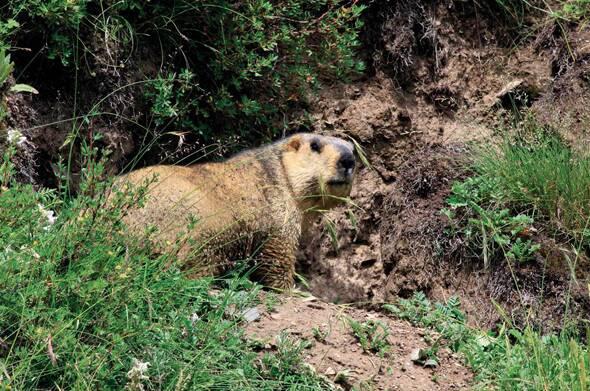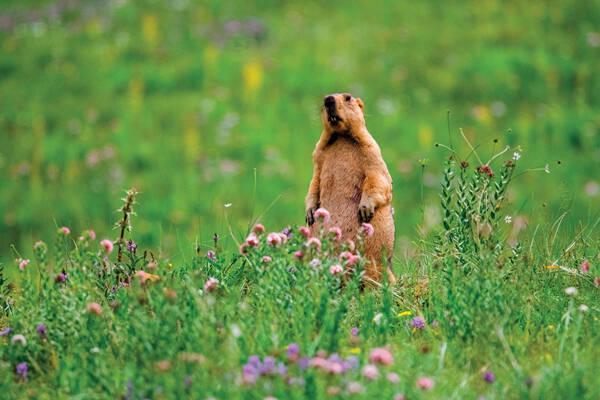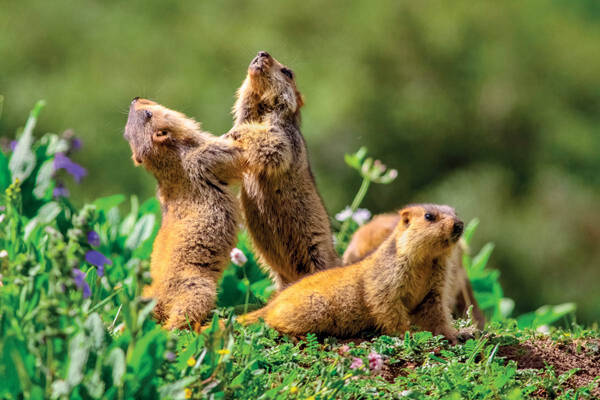Marmota himalayana
IUCN
LCBasic Information
Scientific classification
- name:Marmota himalayana
- Scientific Name:Marmota himalayana,Hara, Snow Pig
- Outline:Rodents
- Family:Rodentia Sciuridae Marmota
Vital signs
- length:47-67cm
- Weight:5-6kg
- lifetime:
Feature
The body is brownish yellow with scattered black markings, the body is stout and fat, and the tail is short.
Distribution and Habitat
In China, it is distributed in Tibet, Sichuan, Yunnan, Qinghai, Gansu and Xinjiang. Abroad, it is distributed in India, Nepal, Pakistan and other places.
It mainly lives in alpine meadows with an altitude of about 3500-5500m and has a strong ability to withstand drought environments.
Appearance
The upper part of the nose and the area between the eyes are dark brown, the snout is often spotted with black or light dark brown, and the forehead is mixed with light yellow. The narrow area of the muzzle from the nose pad to the eye and from the eye to the base of the ear is bright ochre yellow to ochre yellow reddish brown. The back of the whole body is a mixture of light yellow and black, with the central area of the back being darker. The cheeks and limbs are light yellow. The ventral surface of the whole body is light or orange-yellow, with a black-gray base of hair. The skull is large, strong and flat. The postorbital abruptness is well developed, and the sagittal ridge is obvious. The rear end of the nasal bone passes the level of the front edge of the eye socket.
Details
The Himalayan marmot is a large ground-dwelling rodent mammal of the genus Marmot. It widely inhabits the meadow grasslands of the Tibetan Plateau and alpine grasslands at 1500-4500m. Their numbers do not vary significantly depending on the different vegetation communities on the meadow grasslands. changes are mainly affected by terrain. The foothill plains and the lower edges of the sunny slopes of mountains are areas where Himalayan marmots gather at high densities. On terraces, slopes and on valley walls, there are medium numbers. In other areas, there are few or none. On flat land, its distribution is mostly diffuse, that is, it is relatively even over a large area; on hillsides, valleys, and hilly areas, it is often distributed in a strip along contour lines, and it is also densely distributed in small plots of land with superior living conditions. Condition.

Day activities at Himalayan Marmot Camp. When hibernating in early spring, after the sun rises and the ground temperature is high, they come out of the cave to warm themselves first and then look for food. They also lie down outside the cave at noon and enter the cave before sunset. After the weather warms up in summer, more holes will appear during dawn and dusk. There are activities in rain and snow (spring snow) fashion. They hibernate in the cave in winter, and the cave entrance is blocked during hibernation. The activity range is often centered on the nest area, the activity radius generally does not exceed 500 meters, and there is a relatively fixed route. It can sit upright, like a tree stump, and look far into the distance. It has well-developed hearing and is difficult to approach. When it finds a foreign object, it makes a "goo-bi-goo-bi" cry and calls out endlessly; when it gets close, it crawls into a hole.
Himalayan marmots mainly feed on herbs to maintain their basic survival, and eat less grass near the cave entrance. In nature, they will not eat many types of food (including grass) placed at the entrance of the cave. It likes to eat young grass stems, leaves and twigs with dewdrops. Occasionally, they will capture some insects and small rodents for food, and sometimes they will go near the farming area to steal seedlings, stems and leaves of highland barley, oats, rape, potatoes and other crops. In early spring, before the grass has sprouted, Himalayan marmots will dig up grass roots.

Himalayan marmots are social animals, and their cave nests are family-type. Each family is composed of a pair of heterosexual otters and one or two instar cubs. Sometimes several families live together, and 24 hibernating marmots were once found in a cave. There is also a situation of one hole and one beast in summer. They live together in a cave system, and the young leave when they reach sexual maturity.
Himalayan marmots generally only build one nest, which is divided into a temporary hole and a dwelling hole. The dwelling hole is divided into two types: winter hole and summer hole. Both winter caves and summer caves can be used as breeding and resting places. The internal structure of the temporary cave is relatively simple, with only a chamber but no nest. The internal structure of the winter cave is relatively complex. There are several cave entrances, and there are mounds in front of the cave entrances. They are mostly distributed around habitat caves and foraging sites. They are used to avoid natural enemies and can also be used as a resting place at noon in summer. The entrance of the temporary cave is small, the claw marks on the cave wall are obvious, there are footprints at the entrance and exit, and sometimes there is feces.
Himalayan marmots have the habit of hibernating and begin to accumulate fat since the end of spring to meet their physiological needs during the winter. The hibernation time depends on the local phenology. Generally, the hibernation begins in September and ends in mid-October. The hibernation begins from April to the end of April of the following year. The time of entering and exiting hibernation basically depends on the time when the grass withers and turns green.
The fur of Himalayan marmots turns gray after emerging from hibernation, and the tips of the needle hairs are more obviously frayed. Molt once a year. Moulting begins in late spring and early summer. The hair starts to change from the back, then extends to the sides and buttocks, and then to the head, tail and limbs. By the beginning of autumn, all the new hair has grown.
Himalayan marmots reproduce once a year and give birth to one child per year. The gestation period is about 35 days. Each litter has 2-9 cubs, with 2-4 being the most.
Himalayan marmot fur is of good quality, with solid, pliable and elastic skin, flat guard hairs and rich villi, making it suitable for clothing and hats; its tail hair and guard hairs are rigid and are the best raw materials for making high-end paintbrushes; its meat is tender and delicious, rich in protein The content is high, and the oil tastes similar to lard. It can be eaten or made into high-grade lubricating oil.

Himalayan marmot meat, oil and bones can be used for medicinal purposes:
1. Marmot meat: treats rheumatic arthralgia, swelling and pain of ankles and knees, and hemorrhoids and fistulas;
2. Marmot Oil: Treats rheumatic paralysis, itchy sores, prurigo, tinea corporis, and chronic ecthyma on the feet;
3. Marmot bone: Take the limb bones, dry them and set aside. It can remove rheumatism and treat muscle and bone pain and numbness of limbs.
The biggest harm caused by marmots is infectious diseases. They are natural hosts of pathogens such as plague, and their ectoparasites are the spreaders of plague, directly endangering human health. When the density is not high, marmots do not cause much harm to the grassland. They only cause harm when there are large numbers, competing with livestock for grass. Each marmot can eat a total of 25kg of grass during the active period (that is, not hibernating); their digging activities damage the grassland. , the soil excavated near the entrance of the hole forms a larger mound. Because the hole is dug deeper, gravel is often dug out of the ground to cover the pasture.








